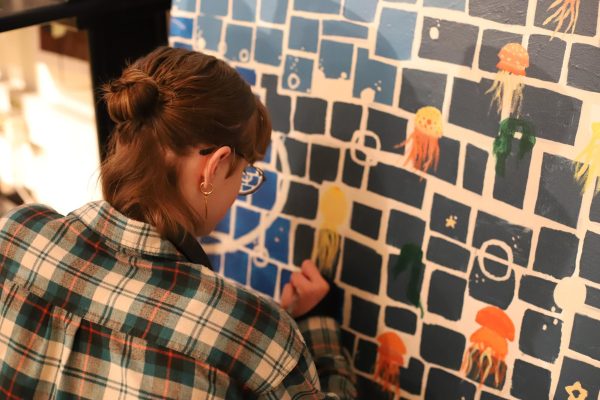Spinning and Winning
Behind the scenes of the color guard during the marching band’s win at the Big Cat competition
During the homecoming game, the band performs their first and second movement for students to see. Halfway through the first movement, the colorguard puts their flag behind them and has to unwind their arms before getting ready to throw it parallel above their heads.
Imagine being in charge of a performance and missing a few rehearsals due to your own things. Moving houses. Being sick. Having a kid. The performance you’re in charge of has only run through the show while you were away. Sean Cartner, director of the marching band, was in this position. With only two run-through’s of the whole show, the marching band was ready to show it off at the competition, Big Cat, at NAAC Stadium.
This is what I was thinking about as I took my first step onto the field with the rest of the color guard last Saturday, October 1. With all my equipment in hand, I tried to step in time. I was in the front of the line, so I felt this especially mattered. Trying to prepare myself further for the performance, I visualized and pretended to do the show in my head. At the beginning of the show, everyone in color guard throws a double with their rifle, a toss that rotates twice in the air before being caught. This one is always hard for me.
I set my last flag, walked past some other band members, and said quietly that they would do great. We all have scary poses we start the show with; I got into mine and took some deep breaths, waiting for the count-in.
One of my favorite parts of the show is getting out of that scary pose at the beginning. I love standing and looking forward at the audience and the drum majors right as everyone starts their movements. I couldn’t enjoy this for too long though, because our rifle choreography started soon, along with the dreaded double toss. I began, throwing a parallel just above my head and transitioning to another toss. At one point I got a little ahead of everyone and had to take extra time for the next move, but I did recover enough to throw the double in time with everyone else. I threw a little too low and thought I’d drop it for sure, but I caught it. I didn’t catch it right, but it ended up in my hands which is a big deal nonetheless.
After this it always feels like the show’s pace gets ramped up, and I have much less time to think before doing things. I only waited for a few measures of music before running to switch out my equipment and to my next spot for more choreography.
This choreography went smoothly at first; I’ve practiced it many times. The harder part is what comes immediately after. We walk while spinning and even end with another toss above our heads. I threw and caught the toss and went to start more, but my step sizes were a little too small and it completely threw me off. I almost ran into one of my teammates doing this. There were other hiccups, but I got through and to the end of this section of the show.
The next movement is the ballad. It features a slower song at a slower pace, and the color guard uses a chain flag. Instead of a pole and silk, the chain flag is just silk with a chain inside of it. This movement is short compared to the others. With the much slower pace, I could really focus on making sure my marching looked good before I have to focus more on my spinning. This part I’ve also practiced a lot. I was able to get past our choreography here without any major issues, and, hopefully, looked good doing it.
The next movement is what really made me nervous. This competition would be the first time Cartner would see the completed movement on the field. There was only one toss to really focus on. I wasn’t too anxious about it; I’ve been getting better at these. In the back of my mind, though, I remembered dropping one on my head during rehearsal last year. I wanted to make sure I didn’t do that during a competition. I got my flag and marched out, ready for the 45 toss, where you throw the flag at about a 45 degree angle above your head. I was able to successfully throw and catch it, though I was a bit late because of my anxiety about it. The next part I had trouble with was making sure I could get to my spot on time while doing our new tick-tock flag move correctly. I couldn’t quite get there, but I still did the move. The rest of the show went smoothly. I got to focus more on my marching and less on other things. At the end of the show I got to run to the back of the field and watch the rest of the band finish. It was such a good feeling.
The show ended and we ran to get our equipment and fall in line with the rest of the band to walk out. This is what really cements the end of the show. It’s crucial we get all of our stuff off the field and get out in good timing so the band doesn’t get points off. I knew I could have done better, and would, during the next performance, but I walked away still feeling like I had made progress nonetheless.
The band placed first out of the 3A bands at the competition.





